Welcome to the fascinating world of ladybug coloring pages, where artistry meets nature’s tiny wonders. These fun illustrations provide a delightful canvas for both the young and the young at heart to explore their creativity while celebrating the vibrant and captivating universe of ladybugs. From their distinctive spotted patterns to their symbolic significance across cultures, these free coloring sheets offer more than just a chance to fill in the lines; they invite us to delve into the educationally informative world of these charming insects, all while indulging in a soothing and meditative activity.

Join us as we embark on a journey through pages brimming with artistic possibilities and a deeper appreciation for the beauty and nature of ladybugs.
Simply select the design that appeals to you, save the available free PDF template, print it, and engage in the joyful act of coloring to your heart’s desire.
Alternatively, these designs can also serve as templates for embroidery or act as inspiration for delicate fine-line tattoos.
Ladybug facts
For those who are discovering my coloring pages for the first time, it’s important to note that I enjoy offering you the choice to delve into the subject matter, transforming the coloring activity into an educational experience.
With that in mind, let’s embark on this enlightening journey together!
Ladybugs are fascinating creatures with a variety of intriguing characteristics. Here are numerous fun and interesting facts about them:
- Variety of Names: Ladybugs are known by different names around the world. In the United Kingdom and other English-speaking countries, they are called “ladybirds.” In Germany, they’re called “Marienkäfer,” which translates to “Mary’s beetle,” referencing the Virgin Mary and their association with luck.
- Symbol of Luck: Ladybugs are often considered symbols of good luck and fortune in many cultures. Their appearance is believed to bring positive outcomes, and finding one is seen as an auspicious sign.
- Spotted Patterns: The iconic spotted patterns on ladybugs serve as a form of camouflage. The colors and spots help them blend into their surroundings, protecting them from potential predators.
- Distinctive Colors: While red with black spots is the most common color pattern, ladybugs can also be black with red spots, orange with black spots, and even more rare color variations. The colors serve as a warning to predators that they might taste unpleasant or be toxic.
- Aphid Predators: Ladybugs are natural predators of aphids, small insects that can harm plants. A single ladybug can consume dozens of aphids in a day, making them beneficial to farmers and gardeners.
- Lifespan: The average lifespan of a ladybug is around one year. Their longevity can vary based on factors such as environmental conditions and availability of food.
- Habitat Variety: Ladybugs are found in a wide range of habitats, from forests and grasslands to gardens and urban areas. They are adaptable insects that thrive in various environments.
- Winter Hibernation: Ladybugs hibernate during the winter months. They gather in groups and find shelter in crevices, under leaves, and in other protected areas to survive the cold.
- Distinctive Smell: Some species of ladybugs release a foul-smelling liquid from their legs when threatened. This acts as a deterrent against predators, keeping them safe.
- Larval Stage: Ladybugs go through a complete metamorphosis, including egg, larval, pupal, and adult stages. The larval stage is often overlooked—these small, spiky creatures look quite different from the adult ladybugs.
- Molt and Growth: Ladybug larvae molt several times as they grow. After each molt, they become larger and their spots become more prominent.
- Environmental Indicators: The presence of ladybugs can be an indicator of the health of an ecosystem. A healthy population of ladybugs suggests a balanced ecosystem with abundant prey and minimal pesticide use.
- Invasive Species: The Asian lady beetle (Harmonia axyridis) is an invasive species that has become widespread in various parts of the world. While it’s a beneficial predator, it can also outcompete native ladybug species.
- Flight Skills: Ladybugs are skilled fliers and are capable of covering long distances in search of food and suitable habitats.
- Scientific Name: The scientific name for ladybugs is “Coccinellidae.” This name is derived from the Latin word “coccineus,” meaning “scarlet,” reflecting the common red coloration of these insects.
- Cultural Significance: Ladybugs have cultural significance beyond their role in nature. They appear in myths, folklore, and children’s stories, often representing concepts like luck, protection, and transformation.
- Mating Rituals: Male ladybugs often engage in elaborate courtship rituals to attract females. These rituals may involve intricate movements and behaviors to display their suitability as mates.
- Ecdysis: Ecdysis is the process by which ladybugs shed their exoskeletons to accommodate growth. The new exoskeleton underneath gradually hardens, and the ladybug emerges larger and more vibrant.
- Predator Mimicry: Some insects mimic the appearance of ladybugs to protect themselves from predators. These mimicry tactics are nature’s way of leveraging the ladybug’s reputation for being unpalatable.
- Population Decline: In recent years, there has been concern about declining ladybug populations. Habitat loss, pesticide use, and climate change are among the factors contributing to their decline.
From their vivid appearance and diverse species to their essential role in maintaining ecological balance, ladybugs continue to capture our fascination.
These small, seemingly simple insects are a testament to the intricate marvels of the natural world. We learned a lot about ladybugs, but there is so much more to know about them.
If you would like to continue your educational journey into the world of ladybugs, here are some other reputable resources to learn about them while coloring:
- https://en.wikipedia.org/wiki/Coccinellidae
- https://kids.nationalgeographic.com/animals/invertebrates/facts/ladybug
- https://kids.britannica.com/kids/article/ladybug/571160
- https://a-z-animals.com/animals/ladybug/
- https://animals.sandiegozoo.org/animals/ladybug
- To see all of my free printables, go here.
- If you would like to see my index of free printable coloring pages, go here!
- To see all of my animal coloring pages, go here.
- To see all of my insect-related coloring pages, go here.
Printing instructions
*Keep in mind that while these coloring sheets are free, they are for personal use only. Any additional use will need written permission, from me, obtained via email. Thanks.*

How to get best results with your ladybug printable
From writing practice worksheets to various fun designs, there are ladybug printing options for everyone!
Materials
- Standard 8.5"x11" Printing Paper (or quality cardstock)
- Black Ink/Toner
Tools
- Printer
- Computer/ Phone/ Or Tablet To Download To
- Pencil Sharpener
- Colored Pencils
- Eraser (optional)
Instructions
-
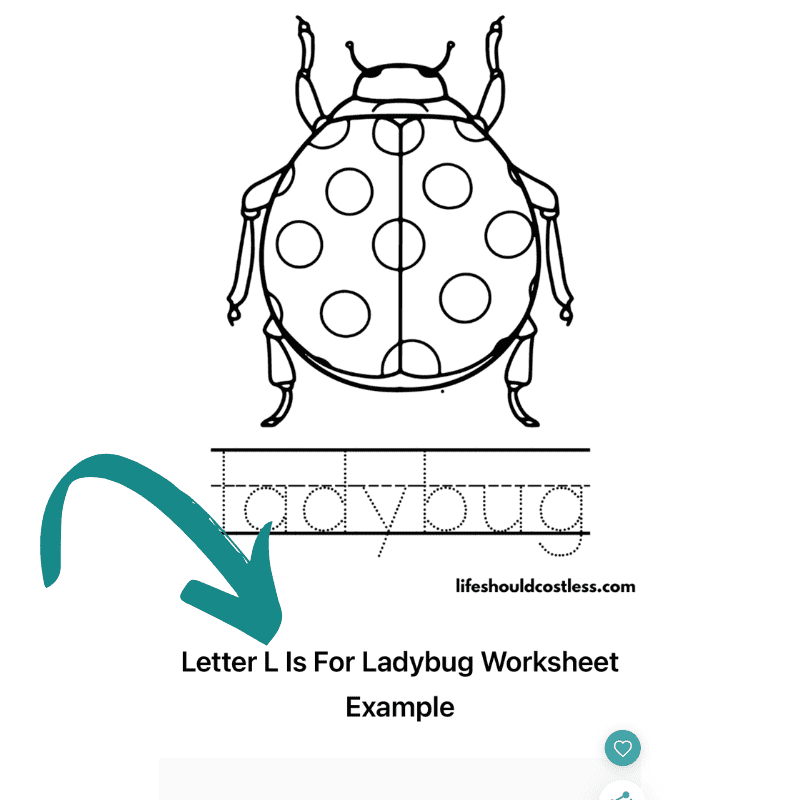 Browse through the options of coloring pages available and select the image or images you would like to color. The provided sample image, featuring the website's watermark, offers an idea of what the complete PDF looks like.
Browse through the options of coloring pages available and select the image or images you would like to color. The provided sample image, featuring the website's watermark, offers an idea of what the complete PDF looks like. -
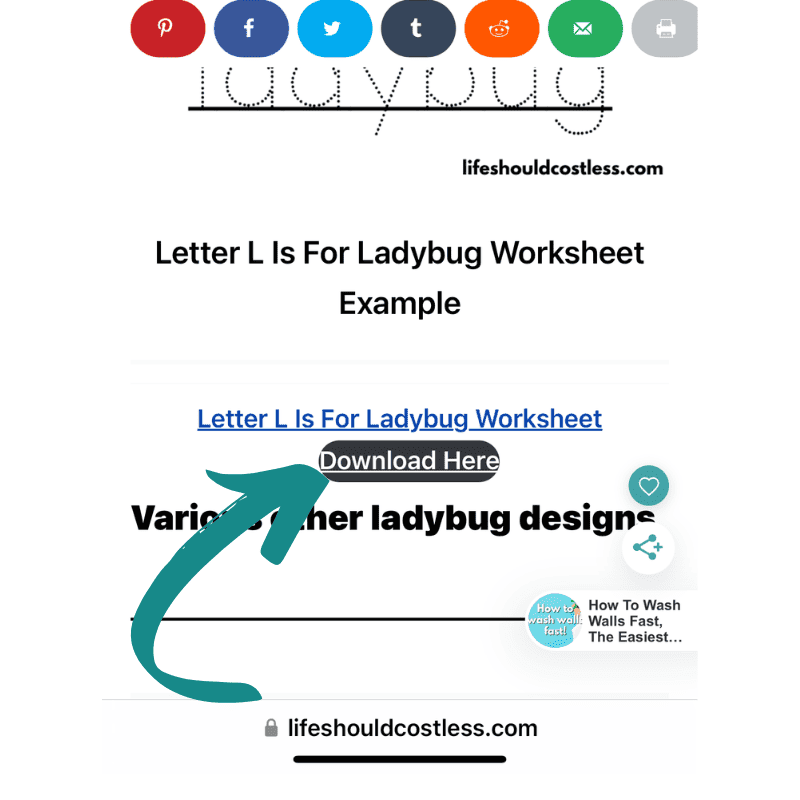 Look just below the preferred sample image to locate the "download here" button for the attached PDF.
Look just below the preferred sample image to locate the "download here" button for the attached PDF. -
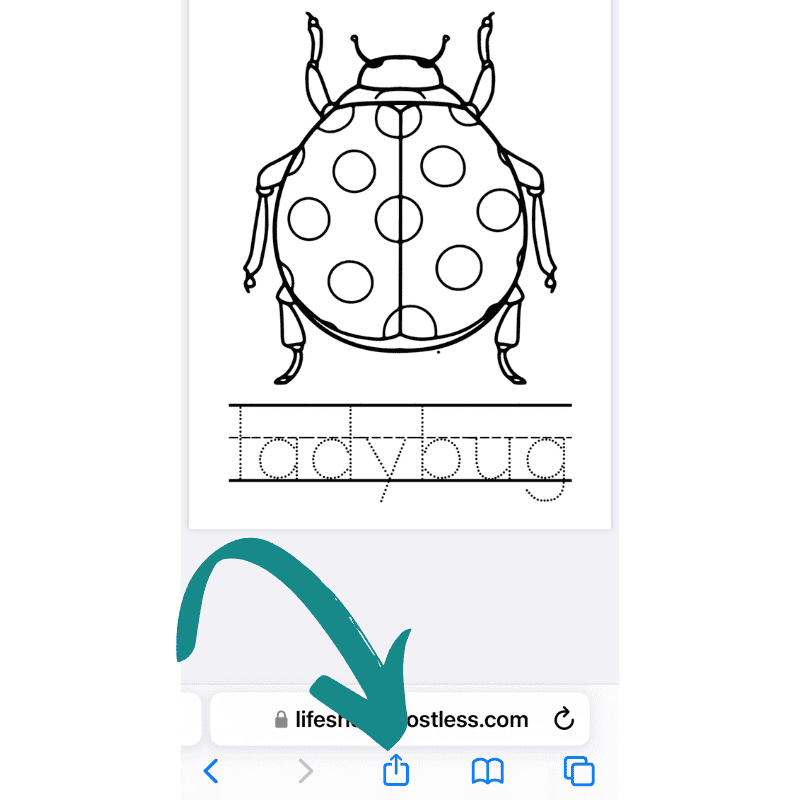
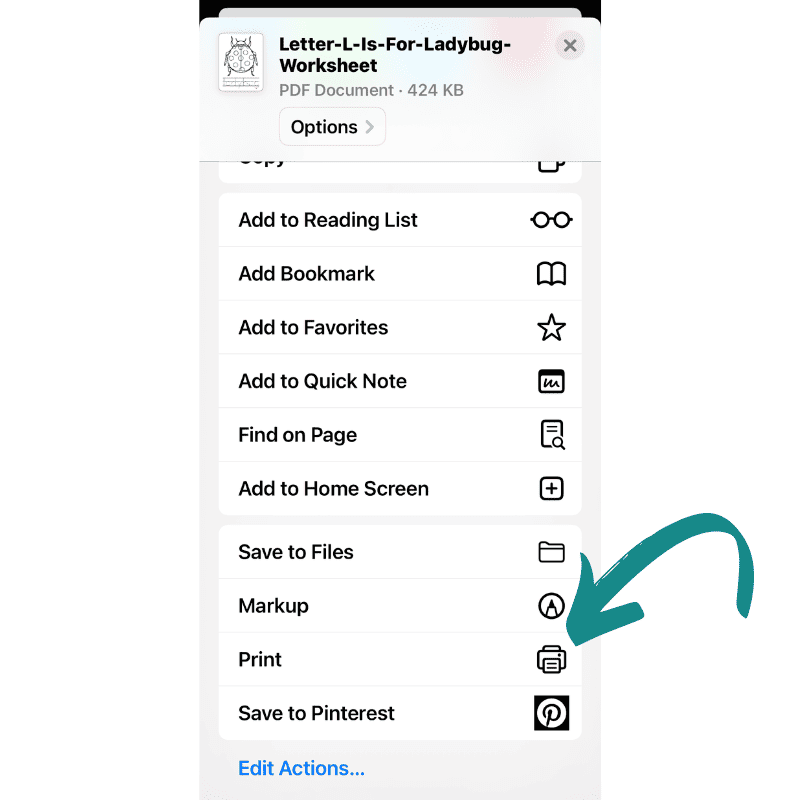 Select download, and then the print options.
Select download, and then the print options. -
 When you're ready to print it out, make sure to choose the maximum-quality setting available. Or the highest DPI (dots per inch) setting accessible. DPI refers to the amount of printed dots within an inch of a printed image, and a greater the number indicates better print quality.
When you're ready to print it out, make sure to choose the maximum-quality setting available. Or the highest DPI (dots per inch) setting accessible. DPI refers to the amount of printed dots within an inch of a printed image, and a greater the number indicates better print quality. -
 Now go ahead and select "print". Send it to your desired printer.
Now go ahead and select "print". Send it to your desired printer. -
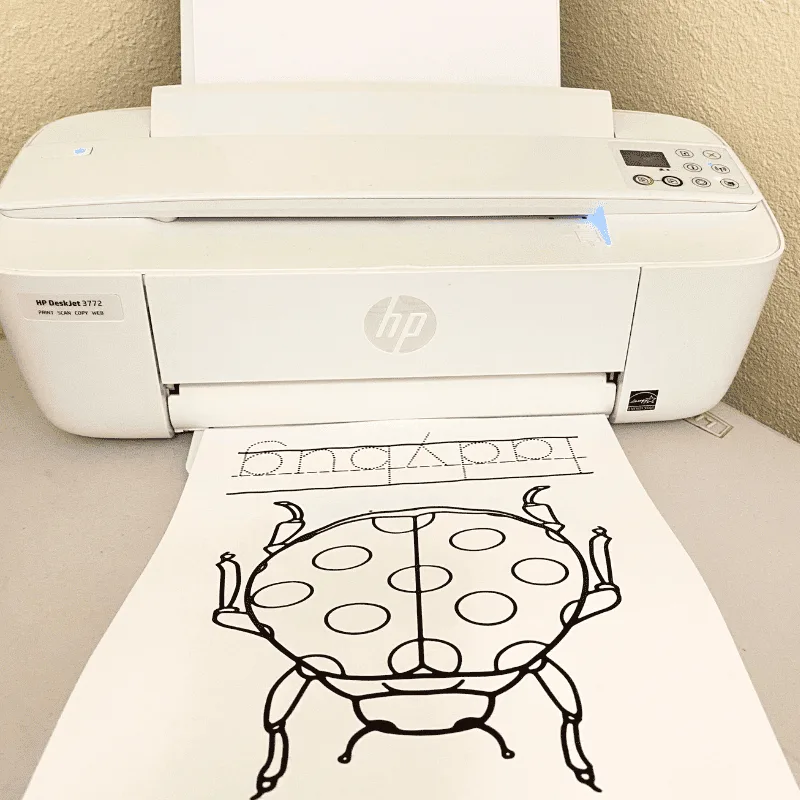 After you have completed printing out your coloring sheet, give the ink a few minutes to completely dry. This extra step will help to avoid any smudging, which is particularly helpful if you would like to gift your artwork to someone.
After you have completed printing out your coloring sheet, give the ink a few minutes to completely dry. This extra step will help to avoid any smudging, which is particularly helpful if you would like to gift your artwork to someone. -
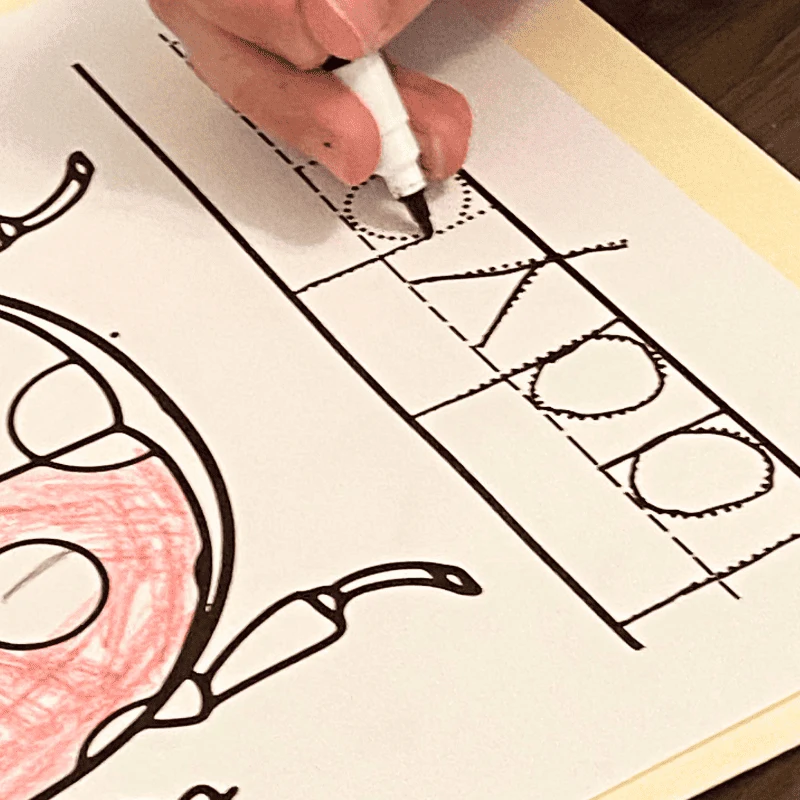 Before you begin coloring your masterpiece, make sure your hands have been washed and are completely dry. Locate a clean and flat surface to place your paper on, and then let your creativity flow as you color the prints however you wish. Once you're done, enjoy the new-found sense of accomplishment, knowing that these artwork creations can possibly bring joy to you and others for many years to come.
Before you begin coloring your masterpiece, make sure your hands have been washed and are completely dry. Locate a clean and flat surface to place your paper on, and then let your creativity flow as you color the prints however you wish. Once you're done, enjoy the new-found sense of accomplishment, knowing that these artwork creations can possibly bring joy to you and others for many years to come.
Notes
Ideas on what to do with these ladybug pictures:
You could buy some simple frames, and have them printed onto quality card stock at a local printing company, color them as well as possible, and they could be added to your home decor.
You could print the pages out and bind them, pair them with some nice colored pencils or an art set, which could be a fun but unique gift for any coloring enthusiast's special day...or any time you wish to cheer someone up.
Alternatively, they can serve as inspiration or templates for delicate fine-line tattoos.
These free ladybug coloring pictures can also be used as embroidery patterns using transfer sheets.
Naturally, you also have the choice to print them and enjoy boundless amusement by coloring them repeatedly.
*Guidelines for achieving the finest print quality are primarily tailored to iPhone users with an HP printer, although they should be similarly applicable to other devices.
**Whenever feasible, opt for the "fit to page" setting before printing to ensure the entire image is encompassed within your printed coloring page.
***It's worth mentioning that this website employs an image optimizer for the sample illustrations. This optimization improves loading speed, albeit with a slight reduction in quality. For optimal results, we recommend downloading and directly utilizing the PDF file. The sample image serves to provide a general visual preview, as navigating through an entire PDF might present challenges on certain devices, potentially hindering the ability to view the complete image in a single screenshot.
Recommended Products
Please note that I am an affiliate with Amazon.com. When you purchase through my suggested product links, the cost for you is the same but I do receive a small commission for everything in your shopping cart. Thanks so much for the support!
-
 Printworks Vanishing Embroidery Transfers, for White/Light-Colored Fabrics, 12 Sheets, Inkjet, 8.5 x 11 (00524)
Printworks Vanishing Embroidery Transfers, for White/Light-Colored Fabrics, 12 Sheets, Inkjet, 8.5 x 11 (00524) -
 eletecpro 12x16 Picture Frames Set of 5, Display 8x10 or 8.5x11 Photo Frame with Mat or 12x16 without Mat, Wall Gallery Poster Frames, Photo Frames Collage for Wall Display
eletecpro 12x16 Picture Frames Set of 5, Display 8x10 or 8.5x11 Photo Frame with Mat or 12x16 without Mat, Wall Gallery Poster Frames, Photo Frames Collage for Wall Display -
 Sacnahe Tattoo Transfer Stencil Machine Copier Printer Thermal Tattoo Kit Copier Printer With 20pcs Free Tattoo Stencil Transfer Paper Black (2023 Update Version)
Sacnahe Tattoo Transfer Stencil Machine Copier Printer Thermal Tattoo Kit Copier Printer With 20pcs Free Tattoo Stencil Transfer Paper Black (2023 Update Version) -
 PRINA Art Supplies 120-Color Colored Pencils Set for Adults Coloring Books with Sketchbook, Professional Vibrant Artists Pencil for Drawing Sketching Blending Shading, Quality Soft Core Oil Based
PRINA Art Supplies 120-Color Colored Pencils Set for Adults Coloring Books with Sketchbook, Professional Vibrant Artists Pencil for Drawing Sketching Blending Shading, Quality Soft Core Oil Based -
 U.S. Art Supply 163-Piece Mega Deluxe Art Painting, Drawing Set in Wood Box, Desk Easel - Artist Painting Pad, 2 Sketch Pads, 24 Watercolor Paint Colors, 24 Oil Pastels, 24 Colored Pencils, 60 Crayons
U.S. Art Supply 163-Piece Mega Deluxe Art Painting, Drawing Set in Wood Box, Desk Easel - Artist Painting Pad, 2 Sketch Pads, 24 Watercolor Paint Colors, 24 Oil Pastels, 24 Colored Pencils, 60 Crayons -
 Looney Zoo Temporary Tattoo Markers for Skin, 10 Body Markers + 20 Large Tattoo Stencils for Kids and Adults, Dual-End Tattoo Pens Make Bold and Fine Lines with Cosmetic-Grade Temporary Tattoo Ink
Looney Zoo Temporary Tattoo Markers for Skin, 10 Body Markers + 20 Large Tattoo Stencils for Kids and Adults, Dual-End Tattoo Pens Make Bold and Fine Lines with Cosmetic-Grade Temporary Tattoo Ink
Coloring tips
Here are best tips and tricks to really get the best experience when coloring your ladybug pictures.
- Color Choice:
- Base Color Variation: While red is the traditional color for ladybugs, consider exploring shades like crimson, scarlet, or vermilion. Also, experiment with non-traditional colors like orange, yellow, or even blue for a creative twist.
- Spot Color: When choosing colors for the spots, opt for a shade slightly darker than the base color. This contrast will make the spots pop and give depth to your artwork.
- Layering and Blending:
- Gradual Layering: Start with a light layer of color and gradually build up intensity by adding multiple layers. This technique creates a smooth and vibrant appearance.
- Blending Techniques: If you’re using colored pencils, experiment with different blending techniques. Try layering similar colors to create gradients or use a colorless blender pencil for a seamless transition between shades.
- Textures and Patterns:
- Shell Texture: Ladybugs have a glossy, textured shell. To mimic this, use small circular strokes with your coloring tools. Layering different shades and alternating between light and heavy strokes can give a realistic texture effect.
- Spot Patterns: Ladybug spots aren’t always perfectly circular. Try irregular shapes, elliptical patterns, or even abstract designs within the spots to add character to your ladybug’s appearance.
- Highlighting and Shading:
- Highlights: Leave tiny areas uncolored or use a white gel pen to create highlights where light would naturally reflect off the ladybug’s shell.
- Shading: Study reference images to understand how shadows fall on ladybugs. Add subtle shading to the undersides and edges of the ladybug’s body to create a sense of volume.
- Background Consideration:
- Contrasting Backgrounds: Select a background color that contrasts with the ladybug’s colors to make it stand out. A warm-colored ladybug might pop against a cooler background, and vice versa.
- Nature-Inspired Backgrounds: Consider adding elements like leaves, grass, or flowers to create a realistic setting for your ladybug. This adds depth and context to your artwork.
- Reference Images and Observation:
- Realistic Details: Observe real ladybugs or high-quality images to understand the intricate details of their anatomy, spots, and overall appearance. This will enhance the accuracy of your coloring.
- Natural Variations: Ladybugs in nature can have slight color variations, unique spot patterns, and sizes. Incorporating these natural variations can make your artwork more authentic.
- Different Coloring Tools:
- Colored Pencils: These allow for precise control and layering. Use different pressures and techniques to achieve various effects.
- Markers: Markers provide vibrant and bold colors. Experiment with layering and blending by using different shades.
- Watercolors: Watercolors create a soft and translucent effect. Experiment with wet-on-wet and wet-on-dry techniques for interesting textures.
- Fine Details and Finishing Touches:
- Antennae and Legs: Use fine-tip markers or pens to add the delicate features like antennae, legs, and facial details.
- Veins and Lines: For added realism, lightly sketch in faint veins on the wings or subtle lines on the shell to replicate the intricate patterns found in nature.
- Practice and Patience:
- Practice Sheets: Before coloring your main artwork, use a scrap sheet to experiment with color combinations, shading techniques, and patterns.
- Take Breaks: Coloring can be intricate and time-consuming. Taking short breaks allows you to return with fresh eyes and renewed enthusiasm.
- Personal Creative Touch:
- Whimsical Interpretations: Don’t hesitate to add a touch of fantasy to your ladybug coloring. Imagine ladybugs with patterns reminiscent of other creatures or adorned with imaginative accessories.
Remember, the process of coloring is as enjoyable as the final result.
These tips and tricks provide a foundation, but your creativity is what truly brings your ladybug coloring sheet to life.
Experiment, explore, and most importantly, have fun!
Options For Printing:
Letter L is for ladybug writing practice worksheets
*My letter L is for ladybug printable coloring sheets have been exclusively crafted for classroom use, making them the sole printable resources on this page that can be freely utilized without requiring written authorization for public settings.
Should anyone inquire about their source, kindly share the link to this post.
Your support is greatly appreciated. Thank you!
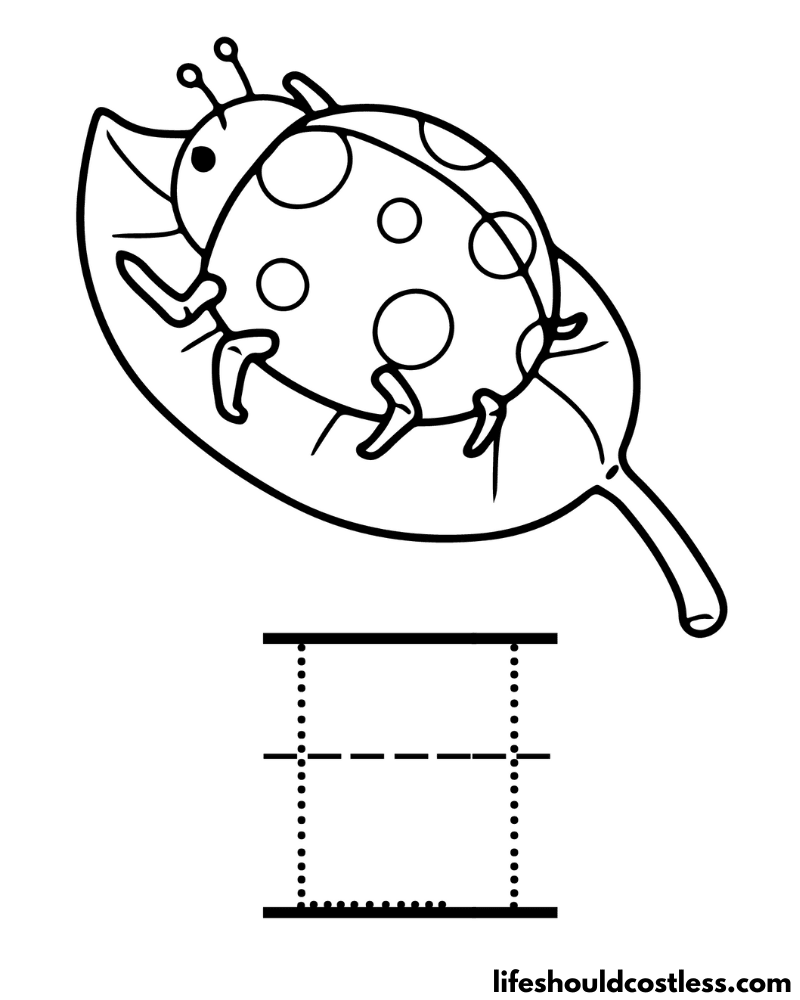
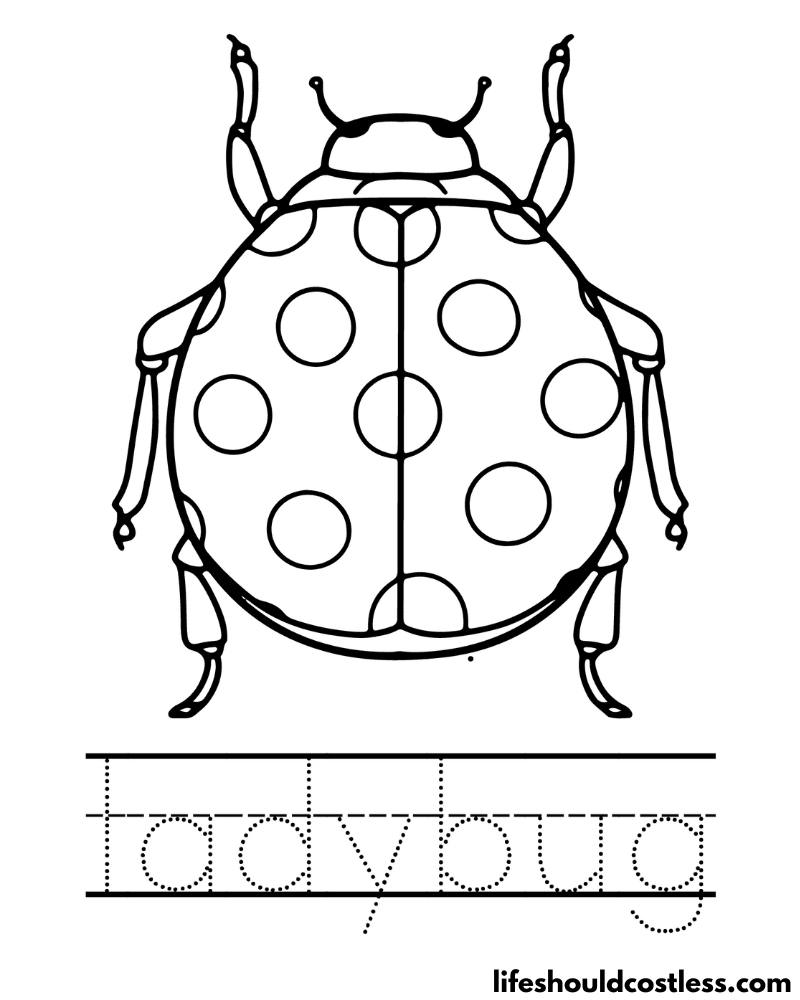
Various other ladybug designs


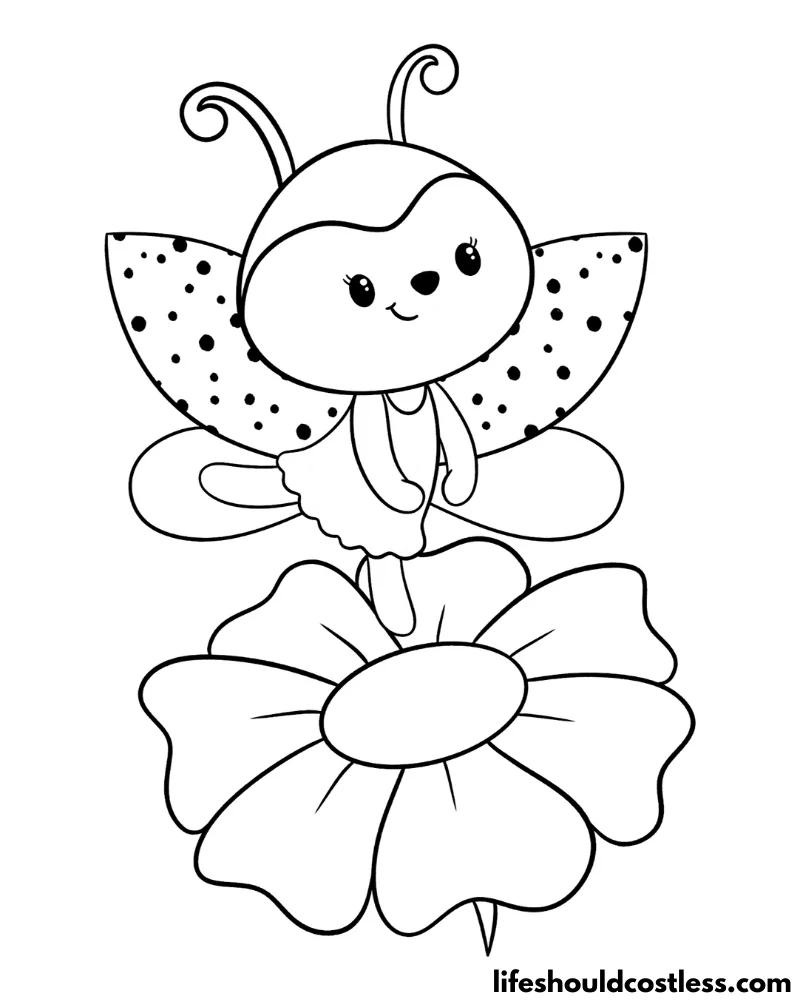

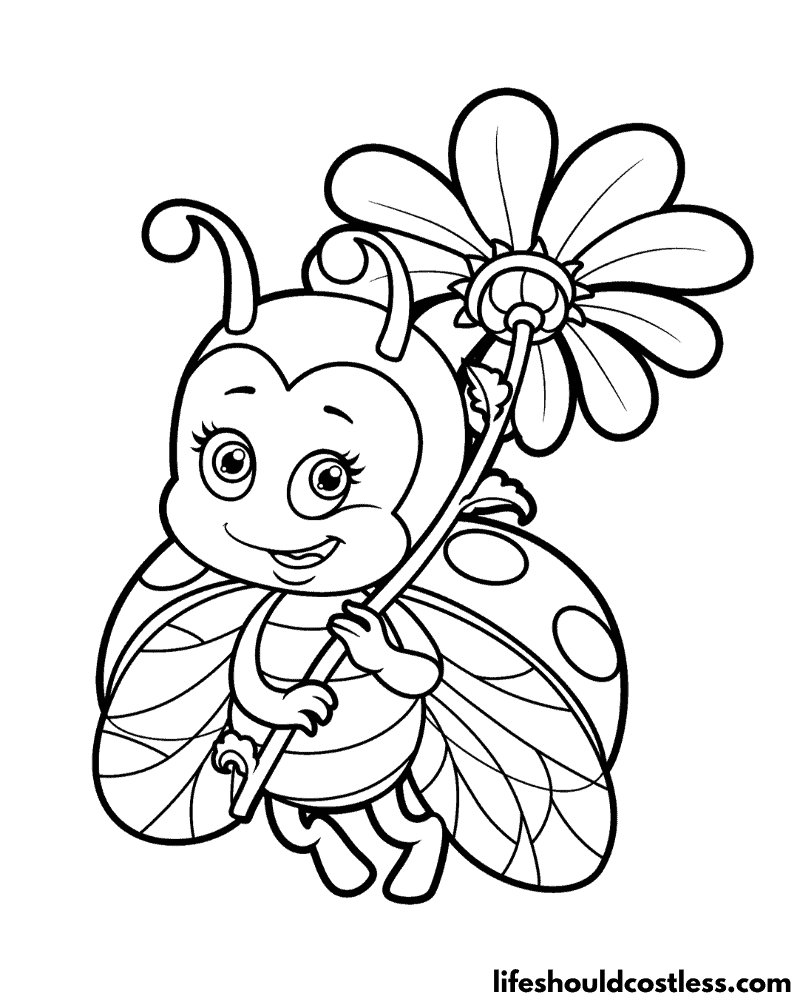
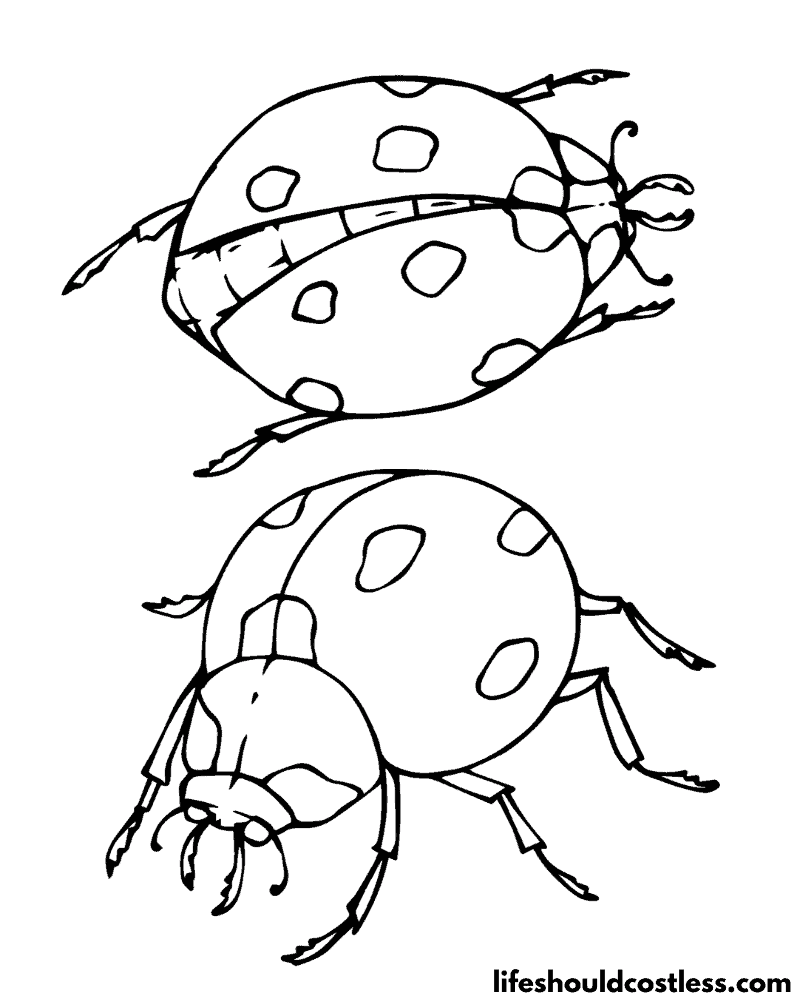
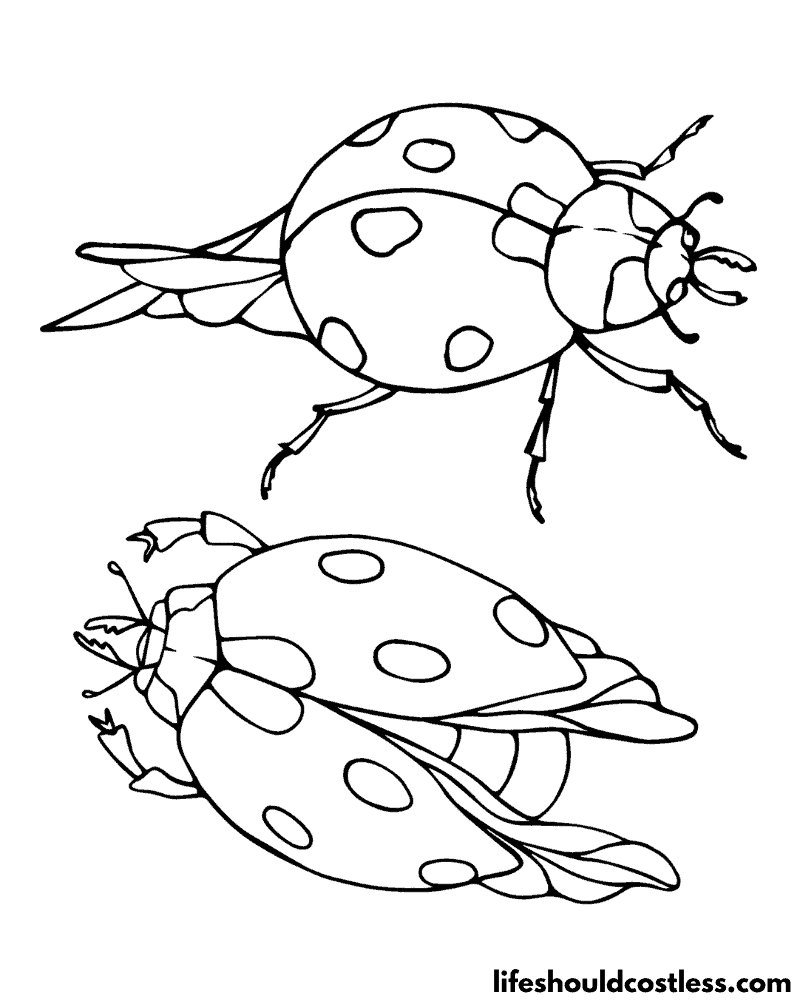

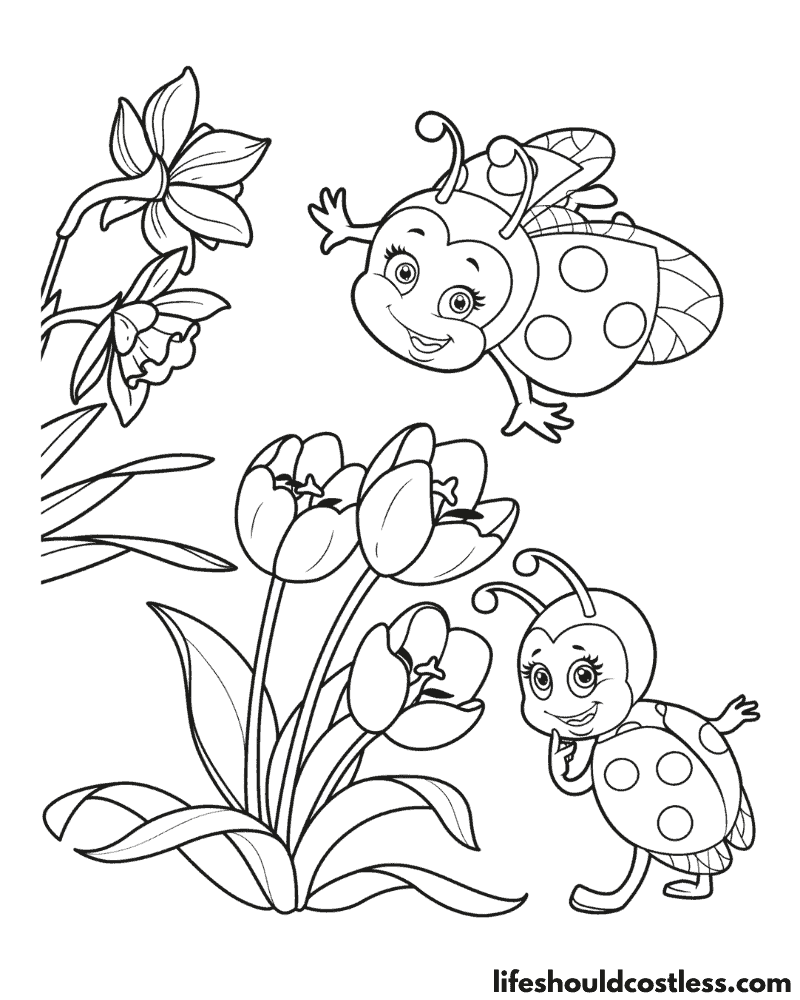
FAQ’s
A real ladybug, also known as a ladybird beetle or lady beetle, can come in a range of colors, but the most common and iconic coloration is red with black spots.
This classic color combination is what many people immediately associate with ladybugs. However, it’s important to note that ladybugs can also exhibit different color variations, such as orange with black spots, yellow with black spots, and even black with red spots.
The colors serve as a warning to predators, indicating that they might taste unpleasant or be toxic, a phenomenon known as aposematism.
The primary difference between red and orange ladybugs lies in their coloration. While both types of ladybugs are members of the same insect family and share similar characteristics, their distinct colors can indicate different species or variations within species. Here’s a closer look at the differences between red and orange ladybugs:
Red Ladybugs:
Color: Red ladybugs are the classic and most commonly recognized coloration. They have a bright red body with distinct black spots.
Species: The red ladybug with black spots is often associated with the “Coccinella septempunctata” species, which is one of the most widespread and recognizable ladybug species.
Orange Ladybugs:
Color: Orange ladybugs have an orange or reddish-orange body with black spots. The shade of orange can vary, ranging from pale orange to deep reddish-orange.
Species: Orange ladybugs can belong to different species, and variations in color can sometimes indicate different stages of development or regional differences.
It’s important to note that ladybugs exhibit a high degree of color variability within species. This means that while red and orange are distinct colors, there can be various shades and patterns within each category.
Additionally, ladybugs can change color slightly as they age or in response to environmental factors.
For both red and orange ladybugs, the coloration serves as a form of aposematism, warning potential predators that they might taste unpleasant or be toxic. This defense mechanism helps protect ladybugs from being eaten by other animals.
Ultimately, the difference between red and orange ladybugs primarily lies in their specific color variations, and these variations can be influenced by factors such as genetics, environment, and development.
*I will add more ladybug colour / color questions and answers as the questions get sent to me.
Conclusion
In the enchanting world of ladybug coloring pages, we have embarked on a journey of creativity and appreciation for these charismatic insects.
As we explored the intricate patterns and vibrant colors that adorn their tiny forms, we discovered the art of translating nature’s wonders onto the canvas.
From experimenting with color variations that breathe life into these charming creatures, to embracing diverse techniques that mimic the texture of their shells, our coloring endeavors have allowed us to delve into the fascinating realm of ladybugs.
Through each stroke of the pencil or brush, we’ve not only indulged in a meditative and enjoyable activity but also gained insights into the science, symbolism, and beauty of these insects.
As our ladybug-themed masterpieces come to life, they remind us of the wonders that await when we blend imagination with nature’s awe-inspiring creations.
So, whether the ladybugs on our pages are red, orange, or even an artistic invention of our own, the artistry and appreciation we’ve cultivated will continue to flourish beyond the coloring sheets, igniting our curiosity and wonder for the world around us.
Thanks so much for stopping by my blog and supporting my endeavors to make people’s lives a little easier/better/more affordable.
If you liked this post, or found it helpful in any way, please make sure to share it with your family, friends, and co-workers via social media.
Or you could even send them the direct link via email. Whichever way you choose to spread the love, I super appreciate it! ~Sarah
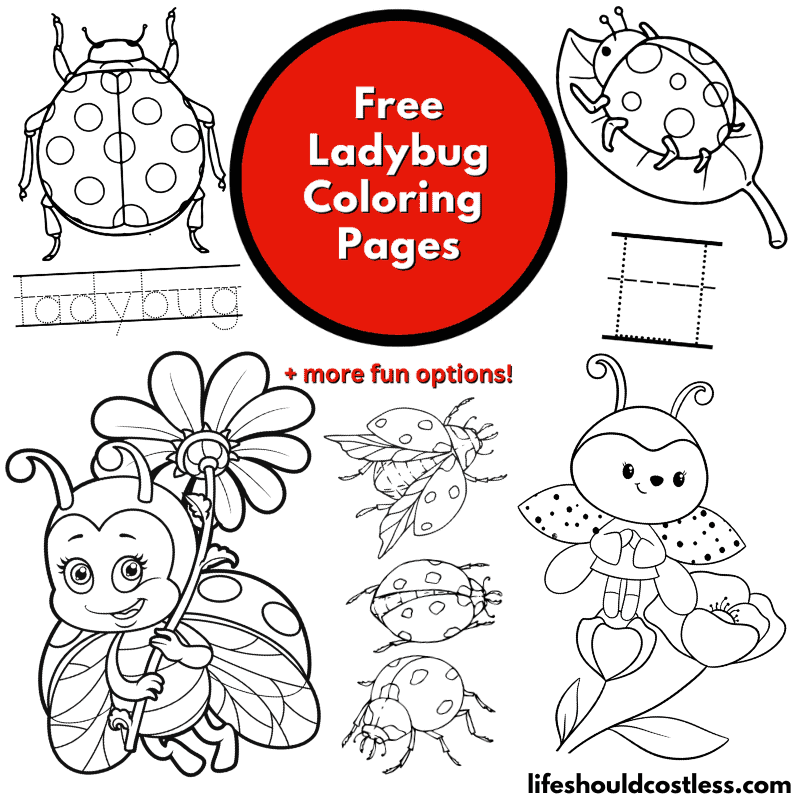
How To Follow & Support This Site
- If you would like to subscribe to my email list, go here.
- Make sure to follow along via social media, by going here.
- If you would like to learn how to really show your support to this site (at no cost to you), go here.
- If you would like to make a direct donation to the site, go here.
Check out my other free printables
- To see all of my free printables, go here.
- If you would like to see my index of free printable coloring pages, go here!
- To see all of my animal coloring pages, go here.
- To see all of my insect-related coloring pages, go here.
Otherwise, here are direct links to several of my other related posts that you’re also going to love:
Animals / Insects
Animals / Birds
Animals / Mammals
Other good resources for a printable ladybug
- https://clipart-library.com/cute-ladybug-coloring-pages.html
- https://www.livinglifeandlearning.com/ladybug-coloring-pages.html
- https://www.homemadegiftguru.com/ladybug-coloring-page.html
*This post was originally shared to this blog on 08/28/2023, and has since been updated to improve user experience, add video instruction, as well as to make it as shareable as possible across the social medias.
**Please note that I do try my hardest to provide factual, but easy to understand, information about each topic. If you notice a discrepancy in my coloring pages, facts, or see something that you deem “misinformation/incorrect” please make sure to notify me about it. I would prefer that you send me an email with a link to a more reputable resource on that subject, so that I can correct it as soon as possible. Thanks so much for helping this site become the best that it can be!
***Resources from djinkers were used in the production of this article.
